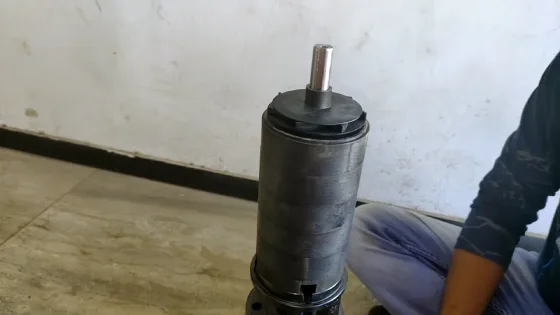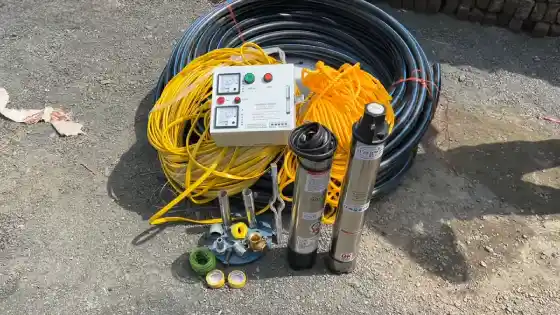Last Updated on July 16, 2023
You want to make sure your submersible pump is working at peak performance, and that means understanding how to calculate its head.
The head of a submersible pump refers to the height that it can pump water, and it’s an essential factor in determining the right pump for your needs.
Calculating the head of a submersible pump requires a thorough understanding of the vertical distances involved in the pumping system.
By accurately determining these distances, you can ensure that the selected pump meets the required water delivery and pressure specifications.
We’ll walk you through the step-by-step process of calculating the head of your submersible pump, as well as discuss factors that can affect your calculation and other important considerations you should keep in mind.
How to Calculate Head of Submersible Pump: Step-By-Step Guide

To calculate the head of your submersible pump, you need to follow a few simple steps. The steps are as follows:
- Step 1: Measure the Static Water Level
- Step 2: Determine the Static Lift
- Step 3: Calculate the Static Discharge
- Step 4: Determine the Total Static Head
Let’s know the steps in detail.
Step 1: Measure the Static Water Level
Measuring the static water level is essential in calculating the head of a submersible pump. It’s the first step towards ensuring the optimal performance of your well system.
To accurately measure the static water level, you can use either a measuring tape or a well sounder. A measuring tape is useful if the well has a small diameter, while a well sounder is ideal for larger wells.
To use a measuring tape, lower it carefully into the well until it touches the water surface. Make sure the tape is straight and perpendicular to the well’s bottom. Once the tape is stable, read and record the measurement on the tape.
If you’re using a well sounder, lower it to the water surface, and then note the measurement on the sounder.
In both cases, be sure to measure at a time when the well is at its normal level, and not when it’s being pumped or filled.
Step 2: Determine the Static Lift
Now that you have the measurement of the static water level, you can determine the static lift by adding the vertical distance from the water level to the highest point where the water needs to be pumped.
The static lift is an important factor in submersible pump head calculations. It’s the distance between the water level and the highest point of discharge and is essential in determining the total head of the pump.
To calculate the static lift, measure the distance from the static water level to the top of the tank or building where the water needs to be pumped. This vertical distance needs to be added to the static water level to obtain the static lift.
It’s important to accurately measure the static lift as any error in the calculation can lead to pump inefficiency, resulting in higher energy consumption and lower pump performance.
Step 3: Calculate the Static Discharge
You can envision the water flowing from the highest point of discharge and imagine the distance it will travel before reaching its final destination.
This distance is called the static discharge, and it’s crucial to calculate it accurately to determine the appropriate submersible pump for your application. Here are the steps to calculate the static discharge:
- Measure the vertical distance from the highest discharge point to the final discharge point.
- Consider any obstructions or bends in the piping system that may affect the flow of water and adjust the measurement accordingly.
- Add the static lift, which is the distance between the water level and the pump, to the static discharge to determine the total dynamic head of the pump.
- Use the total dynamic head to select the appropriate submersible pump for your application.
Step 4: Determine the Total Static Head
To determine the total static head, add the static lift (obtained in Step 2) and the static discharge (obtained in Step 3).
The sum of these two measurements represents the total vertical distance that the submersible pump needs to overcome. This total static head is crucial for selecting a pump that can deliver the necessary flow rate and pressure to meet your requirements.
What Factors Can Affect Submersible Pump Head Calculation?

There are a few key factors to consider when calculating a submersible pump’s head.
1. Static Water Level
Knowing the static water level is crucial in calculating the head of your submersible pump because it determines the initial lift requirement.
The static water level refers to the vertical distance from the water level in the well to the discharge point.
This distance must be accurately measured to ensure that the pump is capable of lifting the water to the desired height.
The static water level can be affected by several factors, including the depth of the well, the water table level, and the amount of water being pumped.
It’s important to regularly monitor the static water level to ensure that the pump is functioning properly and to make any necessary adjustments to the pump’s performance.
2. Static Lift
You can picture the static lift as the distance between the water level in your well and the highest point where you want your water to flow, like a race between the water and gravity.
To calculate the static lift, you need to measure the distance in feet or meters between the water level in the well and the highest discharge point. This can be a storage tank, an elevated structure, or any other point where water needs to be pumped.
Here is an example of calculating the static lift using a submersible pump. Let’s say the water level in your well is 20 feet below the surface, and you want to pump the water up to a storage tank located 80 feet above ground level.
The static lift would be the sum of these two distances, which is 100 feet. You can refer to the table below to understand how the static lift affects the performance of your submersible pump.
| Static Lift (ft) | Pump Performance (%) | Recommended Horsepower |
| 0-10 | 100 | 1/2 HP |
| 11-20 | 95 | 1/2 HP |
| 21-30 | 90 | 3/4 HP |
| 31-40 | 85 | 1 HP |
| 41-50 | 80 | 1 1/2 HP |
As you can see from the table, the higher the static lift, the lower the pump performance. Therefore, it is important to choose a pump with the right horsepower for your specific static lift.
3. Static Discharge
To ensure optimal performance of your water system, it’s crucial to consider the static discharge and the elevation difference between the discharge point and final destination.
The static discharge represents the vertical distance from the highest discharge point to the final destination where the water will be discharged. This is an important factor to consider when calculating the head of a submersible pump, as it directly affects the amount of pressure needed to lift the water to its final destination.
For instance, if the discharge point is higher than the final destination, the static discharge will be positive. This means that the pump will need to generate more pressure to move the water.
Conversely, if the final destination is higher than the discharge point, the static discharge will be negative. Less pressure will be required to get the water there.
Therefore, when figuring out the head of a submersible pump, it’s important to factor in the static discharge to ensure that the pump can deliver the required water pressure to its final destination.
4. Friction Losses
When water flows through pipes and fittings, it experiences friction which can cause the pump to work harder, resulting in higher energy consumption.
Friction losses are influenced by several factors, including the diameter, length and material of the pipes, as well as the fittings and the flow rate.
Here are some things to consider about friction losses:
- Friction losses are a common source of inefficiency in water systems. They can cause the pump to work harder and consume more energy, which can be costly in the long term.
- Reducing friction losses can help improve the overall efficiency of the system. This can be achieved by using larger pipes, reducing the number of fittings, or increasing the flow rate. However, it’s important to balance the benefits of reducing friction losses against the costs of making changes to the system.
5. Elevation Changes
Elevation changes are a crucial factor in calculating the total head requirements of a submersible pump. The pump must overcome the additional vertical distance to push the water to its destination, resulting in a higher head requirement.
It’s essential to include the elevation changes in the total head calculation to ensure that the pump can handle the vertical distance.
To calculate the head required for elevation changes, you need to know the difference in elevation between the water source and destination. This information helps you determine the vertical lift, which is the amount of force required to move the water upward.
6. Pipe Diameter and Length
You may not realize it, but the size and length of your pipes play a significant role in determining the amount of force your water pump needs to operate effectively.
Smaller pipe diameters and longer pipe lengths introduce higher friction losses, requiring your pump to work harder to overcome the resistance and maintain the desired flow rate.
This means that a pump with a higher head rating may be required to compensate for the additional pressure drop caused by the piping system. To emphasize the importance of pipe diameter and length, consider these three factors:
- A small diameter pipe can cause water to move slower, which leads to a higher head loss due to friction. This means you need a pump with a higher head rating to maintain the same flow rate.
- Longer pipes result in higher friction losses due to the increased surface area. This can cause head loss to occur at a higher rate, requiring a higher head pump.
- If the piping system has a lot of bends or elbows, this can also contribute to additional head loss. Even a small bend can cause turbulence and increase friction loss in the system.
7. Pressure Requirements
To get the right pressure at your destination, it’s important to consider how much force your water pump needs to generate. The pressure requirements of your system will determine how much head your submersible pump must generate to achieve the desired pressure.
The higher the pressure required at the discharge point, the more head your pump must generate. Once you have determined the required pressure, you can use a pump curve chart or consult with a pump manufacturer to determine the necessary head and flow rate for your pump.
8. System Efficiency
By evaluating the efficiency of your pump system, you can determine the necessary adjustments to optimize performance and minimize losses.
System efficiency refers to the effectiveness of the individual components that make up the pump system, including the pump itself, piping, valves, and fittings.
Any inefficiencies in these components can result in energy losses, which require additional heads to compensate for and achieve the desired pump performance.
What is the head of a 1 hp submersible pump?

The head of a 1 HP submersible pump can vary according to the model and manufacturer. However, the maximum head range for this pump is between 51 and 100 meters, making it capable of lifting water vertically to that height.
The actual head achieved by the pump may differ depending on several factors, including system configuration, pipe diameter, and friction losses.
It’s essential to note that the pump’s head determines its ability to deliver water and ensure optimal performance in various applications, such as irrigation, mining, and domestic water supply.
Can you oversize a submersible well pump?
You don’t want to make the mistake of choosing a submersible well pump that’s too big for your system, as this can lead to wasted energy and reduced efficiency.
Oversizing a submersible well pump can cause the pump to operate outside its best efficiency range, leading to higher energy consumption and increased wear and tear on the pump.
Additionally, an oversized pump can cause excessive pressure in the system, damaging pipes and other components.
On the other hand, choosing a submersible well pump that is too small can also have negative consequences. An undersized pump may not be able to deliver the required flow rate, which can lead to reduced system performance and ultimately, a decrease in the lifespan of the pump.
Calculate Your Submersible Pump Head Accurately for Optimal Performance
Calculating the head of a submersible pump is crucial to ensure efficient and effective pumping. Following the step-by-step guide, you can determine the total head required for your pumping needs.
Factors such as the pump’s capacity, pipe diameter and length, and the depth of the water source can affect the head calculation. It’s essential to note that oversizing a submersible pump can lead to increased wear and tear, reduced efficiency, and increased energy consumption.
Take the time to calculate the head accurately to avoid costly mistakes. With proper head calculation and pump sizing, you can ensure a steady and reliable water supply from your submersible pump.


